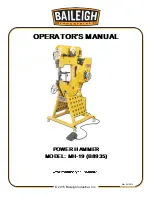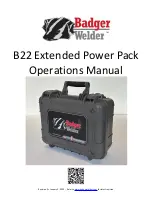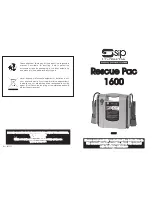
1. KNOW YOUR TOOL
Read and understand the owners manual and labels affixed to the tool. Learn its
application and limitations as well as its specific potential hazards.
2.
Don’t use power tools in damp or wet locations or expose them to rain. Keep work
area well lit and provide adequate surrounding work space.
3. USE RIGHT TOOL.
Don’t force the tool or the attachment to do a job for which it was not designed.
4. WEAR PROPER APPAREL.
Do not wear loose clothing, gloves, neckties or jewelry (rings, watch) because they
could get caught in moving parts. Non-slip footwear is recommended. Wear
protective hair covering to contain long hair. Roll up long sleeves above the elbows.
5. MAINTAIN TOOL WITH CARE.
Keep tool clean for best and safest performance. Follow instructions for operation
and changing accessories.
6. DISCONNECT TOOLS.
Before servicing, when changing accessories or attachments.
7. AVOID ACCIDENTAL STARTING.
Make sure the switch is in the ‘’OFF’’ position before plugging in.
8. USE RECOMMENDED ACCESSORIES.
Consult the manual for recommended accessories. Follow the instructions that
accompany the accessories. The use of improper accessories may cause hazards.
9. CHECK FOR DAMAGED PARTS.
Before further use of the tool, a guard or other parts that are damaged should be
carefully checked to ensure they will operate properly and perform their intended
function. Check for alignment of moving parts, breakage of parts, mounting, and any
other conditions that may affect its operation. A guard or other parts which are
damaged should be properly repaired or replaced.
GENERAL SAFETY INSTRUCTIONS
FOR POWER TOOLS
SPECIFIC SAFETY INSTRUCTIONS
FOR ROTARY TOOLS
Additional Rules for Safe Operation
1. Accessories must be rated
for at least the speed recommended on the tool
nameplate. Wheels and other accessories running over rated speed can fly apart
and cause injury.
2. Do not operate the flexible shaft with sharp bend
. Over-bending the shaft can
generate excessive heat on the jacket or hand piece. The recommended minimum
is 6” radius.
3. After changing the bits or making any adjustments
, make sure the collet nut and
any other adjustment devices are securely tightened. Loose adjustment device can
unexpectedly shift, causing loss of control, loose rotating components will be
violently thrown.
4. Allow brushes to run
at operating speed for at least one minute before using wheel.
During this time no one is to stand in front or in line with the brush. Loose bristles or
wires will be discharged during the run-in time. Wire and bristle brushes must never
be operated at speeds greater than 15,000 min. Direct the discharge of the spinning
wire brush away from you.
5. Do not use a grinding wheel that may be damaged
. Inspect all grinding wheels
and tips before use. Fragments from a wheel that bursts during operation will fly
away at great velocity possibly striking you or bystanders.
6. Use clamps to support workpiece whenever practical.
Never hold a small
workpiece in one hand and the tool in the other hand while in use. Clamping a small
workpiece allows you to use both hands to control the tool. Allow for sufficient space,
at least 6”, between your hand and the spinning bit. When using the steel saws,
cutoff wheels, high speed cutters or tugsten carbide cutters, always have the work
securely clamped. Never attempt to hold work with one hand while using any of
these accessories.
7. Never start the tool when the bit is engaged
in the material. The bit cutting edge
may grab the material causing loss of control of the cutter.
8. If the workpiece or bit becomes jammed or bogged down
, turn the tool “OFF” by
the switch. Wait for moving parts to stop and unplug the tool, then work to free the
jammed material.
9. Do not grind or sand near flammable materials
. Sparks from the wheel could
ignite these materials.























